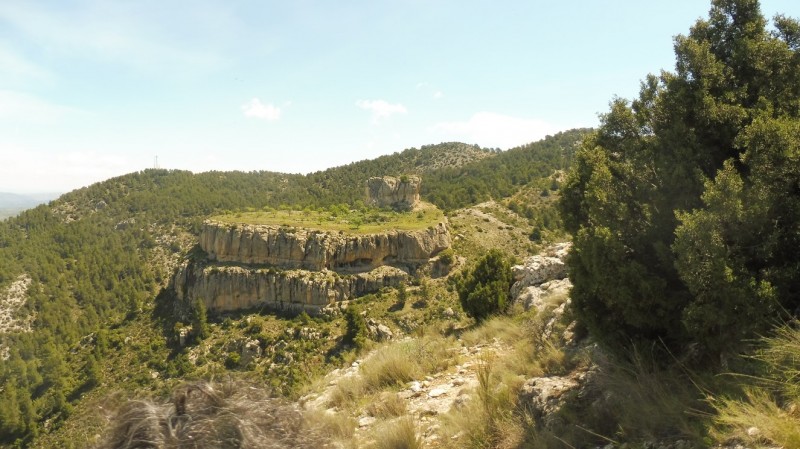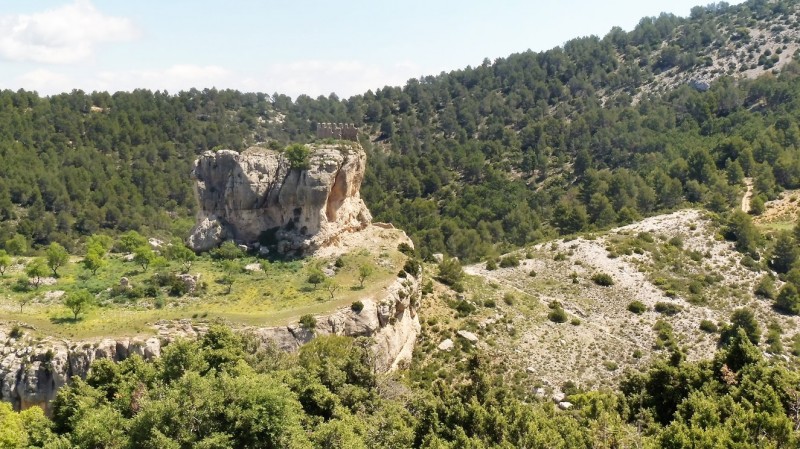article_detail
The castle of Benizar in the mountains of Moratalla
Part of the Moorish battlements can still be seen at the majestic hilltop fortress of Benizar
The remains of the castle of Benizar, in the north-west of Moratalla close to the boundary with the region of Castilla-La Mancha, are perched magnificently on the flat top of a rocky outcrop which rises up above the valley. Down below is the spring of fresh water which runs through Benizar, contributing to what is one of the most strategically advantageous locations imaginable for a fortification and defensive structure.
From the castle and the flat land around it there are views over a wide swathe of farmland as well as the villages of Benizar, El Villar and Otos.
Such is the steepness of the terrain that although the Moors somehow managed to build a castle here, nowadays it is impossible for all but expert rock climbers to reach the castle. It has to be assumed that at some point access was easier, but nowadays it is a steep climb up even to the ledge below the castle.
Historians believe that the castle of Benizar was built towards the end of the 500 years of Moorish rule in the  kingdom of Murcia, but are unable to be more specific than narrowing it down to the 11th or 12th century. What is known, though, is that after the Reconquista by Christian forces was completed in 1243 the fortress was one of those entrusted by Fernando III of Castilla to the Order of Santiago, enabling the warrior knights to strengthen the frontier with the remaining Nazarid kingdom of Granada. The same document by which Benizar was ceded to the Order also handed them control over the fortresses of Moratalla, Socovos, Vicorto, Gontar, Letur, Férez, La Abejuela, Lietor, Nerpio, Taibilla, Yeste and others, as well as all of the farming, fishing and other agricultural activity in all of these locations.
kingdom of Murcia, but are unable to be more specific than narrowing it down to the 11th or 12th century. What is known, though, is that after the Reconquista by Christian forces was completed in 1243 the fortress was one of those entrusted by Fernando III of Castilla to the Order of Santiago, enabling the warrior knights to strengthen the frontier with the remaining Nazarid kingdom of Granada. The same document by which Benizar was ceded to the Order also handed them control over the fortresses of Moratalla, Socovos, Vicorto, Gontar, Letur, Férez, La Abejuela, Lietor, Nerpio, Taibilla, Yeste and others, as well as all of the farming, fishing and other agricultural activity in all of these locations.
The lower enclosure of the castle has long since disappeared, although a series of large water storage tanks have been found which would have enabled those inside to withstand sieges. The remains of a couple of dwellings have also been found, but at present there are more almond trees than visible walls.
Remarkably, though, part of the upper keep is still standing and looks out majestically over the landscape, and it is hard not to wonder at how it possible to build such an imposing structure in such an inaccessible location the best part of a thousand years ago.
The castle was awarded the protected status of Item of Cultural Interest in 1985.
article_detail
Contact Spanish News Today: Editorial 966 260 896 /
Office 968 018 268













